Ireland Pt. 4
The North and Northern Ireland
From Donegal town we made our way north, deeper into the Donegal region, literally.
Our first planned stop is Glenveagh National Park but for some reason Austin sends us down a back road to get there... the back road becomes a gravel road, and the gravel road becomes a muddy road. Our GPS tells us it's only 500 meters to the next turn, so it can't be like this much further, so we go further than we should have, the car is bottoming out on rocks, and I am accelerating to get through muddy sections, when the road appears to end in a grassy trail between two fields. The "road" is too narrow to turn around, so we decide to open a gate into one of the fields, and pull in to turn around. When we are partway through the gate, and the tires are spinning, the stress levels raise a little, we're in the middle of nowhere, stuck in a farmers field.
In the pouring rain, Norine pushes the front of the car, and I gun it to slide back into our road. Norine jumps in, and for a harrowing 5 minutes I drive backwards down a narrow muddy bumpy road, bottoming out, sliding through mud, until we finally come to a barn where we can turn around. We have to stop at a McDonalds in Letterkenny to clean up, change our shoes and socks, and use a small stick to scrape dirt out of the front grill of the car. Not a fun time! Stupid GPS!
After chilling out for a while we chose a different route to get to Glenveagh National Park, and it's center-piece Glenveagh Castle that was built in 1870. Glenveagh consists of a four storey rectangular keep surrounded by a garden, and has a backdrop of some 165.4 km˛ (40,873 acres) of mountains, lakes, glens and woods complete with a herd of red deer.

Glenveagh Castle was built by John Adair, who came to the area, and was so awestruck by the view he had to build a castle here. He purchased the 28,000 acres in 1859 including 244 tenants living in small houses around the property. After one of his stewards was murdered, Adair carried out his threat to evict the tenants in 1861, most believed he evicted 44 families so they would not spoil his view of the landscape. After evicting the Police destroyed the homes, a woman that was evicted cursed Adair and all Glenveagh's subsequent owners that none of them would ever have children. All of the owners died without children including the final owner, Henry Plumer McIlhenny.
McIlhenny purchased the property in 1937, and treated it as a retreat, Hollywood stars such as Marilyn Monroe and Greta Garbo stayed at the castle. McIlhenny was also a gentleman and made amends for Adair's atrocities by bequeathing Glenveagh Castle and all its land to the Irish nation.

It's a bit of a process to get there, you buy bus tickets to get in to the park. Then we had to wait an hour for the tour of the castle, wandered the gardens in the pouring rain

As a photographer, it can be a little frustrating when entering castles and other historical buildings, many of them will not let you take photos inside. For some of them it is to protect the fabrics, paints and artifacts from colour damage created by flash photography, for a lot of them, it's so they can sell you the book or the postcards. $$$ or stealth, your choice.
A Leprechaun of a tour guide showed us through the castle, he was very excited by the rooms and antiques. Maybe just a little too excited by the antiques and paintings, oh leprechauns!
After our muddy mishap, waiting for buses and getting in to the castle, it was already 5 by the time we left Glenveagh. We cut our tour short, and we were off to Mount Royd B&B, an ivy covered cottage, just a short drive from Northern Ireland and 9km from the city of Derry (Londonderry).
The place is adorable, it was the Little Gem Award Winner every year from 2000-2006. When we arrived our award winning landlady gave us tea and pastries and some suggestions about Derry.
It truly is a country home, in the backyard is two Jacobs sheep, chickens, and 2 curious kittens.
The room is very quaint, a mix of grandmas house and colour coordinated fabrics, there is even a night-gowned teddy bear on the bed. A glass door opens onto a patio and we look out onto the backyard at a small fountain, and the collection of farm animals that make the cottage unique.
Derry (Londonderry)
After settling into our room and finishing our tea, we head into Derry. The old walled city of Londonderry lies on the west bank of the River Foyle. The name was changed from Derry in 1613 during the organised colonization (or plantation) of Northern Ireland by people from Britain.
Catholics were discriminated against under Unionist government in Northern Ireland, both politically and economically. In the late 1960s the city became the flashpoint of disputes between British police/Protestants and Catholics. The resulting violence is now referred to as "The Troubles". On Sunday January 30, 1972, 13 unarmed civilians were shot dead by British paratroopers during a civil rights march in the Bogside area. Another 13 were wounded and one further man later died of his wounds. This event came to be known as Bloody Sunday.
Once a cease-fire was formed between the IRA and British authorities, political murals became a key part of the bogside are of Derry, from key events, to victims of the troubles, it's a sombre walk through this part of town imagining what could lead to such violence.
Derry is the only remaining completely intact walled city in Ireland, from the bogside area we made our way past a group of drinking teenagers, and circled the old city using the walls.
From the walls we get a great view of the 1633 gothic Cathedral of St Columb and the Church of Ireland. One building is all boarded up and a vine is overgrowing a window, but there is still a hanging plant. It's an interesting mix of historic, damaged and modern, that makes Derry unique.
The impressive looking Guildhall has a storied history. Built in 1890, then badly damaged by fire in 1908, only the clock tower survived the fire intact. The whole building was re-built and renovated after the fire and was re-opened in 1912. During the troubles in Northern Ireland the Guildhall was the focus of many terror attacks. The building was badly damaged by two bombs in 1972.
There is several unique carvings and plaques on the walls, including Derry's coat of arms, complete with a sitting skeleton and a castle. From the wall we head to a restaurant recommended by our host, The Exchange... very good modern and trendy, short wait but well worth it.
Antrim Coast/Causeway Scenic route
On the day of our Anniversary, we had an amazingly scenic and sunny day. We woke up and after a brief pit stop to drop off our dirty clothes at a laundromat, we headed over Derry's Foyle bridge towards the Antrim Coast along the Causeway Scenic route.
We caught a little bit of clouds when we got the north coast of Ireland, the wind was picking up as we pulled onto Downhill Beach. You turn off the road, and pull right out onto the sandy beach.
It's a beautiful beach, and would probably be packed if it wasn't so windy.
On the hill just above Downhill beach is Mussendon Temple. It was built in 1785 as a library and modeled on the Temple of Vesta in Italy. On the same property is Demesne Temple and the Downhill Mansion built by an eccentric Bishop in 1774 , Much of the building was destroyed by fire in 1851 before being rebuilt in the 1870s. It fell into disrepair after World War II.
Overlooking what must be a couple of very tough golf courses is the Rinagree Coastal Park.
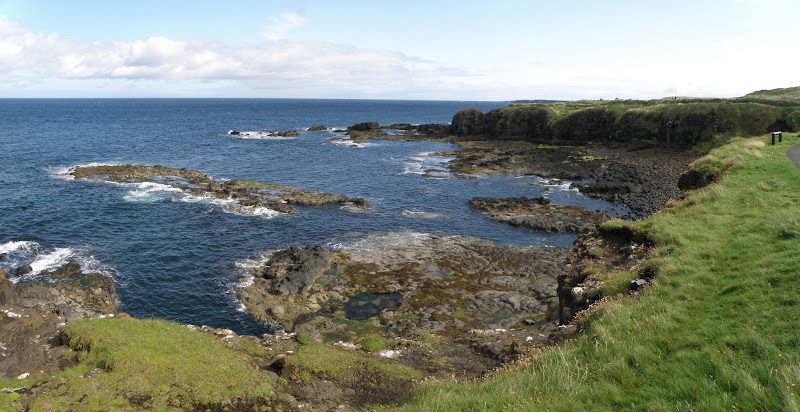
Just outside the town of Portrush is the award winning Whiterocks Beach. There's a lot more people here, as the wind that has continued to get stronger, is creating perfect surfing conditions.
Running between the beach and our next stop is a series of scenic limestone cliffs along the coast.
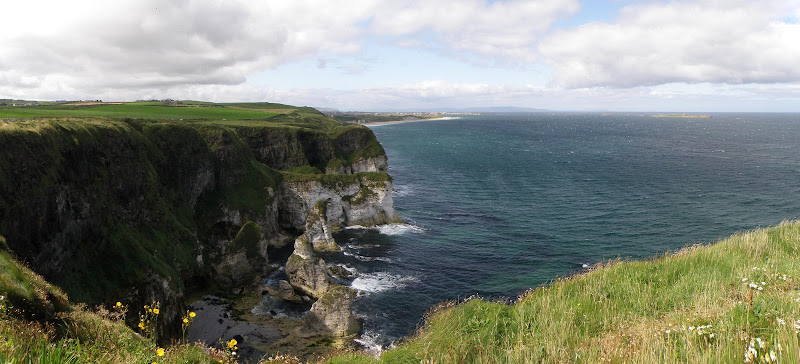
The medieval ruins of Dunluce Castle hang on the edge of some dramatic cliffs. It's position surrounded on three sides by cliffs, and requiring a bridge to access makes it a seem like a perfect position for a fort. The first castle on this location dates back to the 1200's, through the 1600s', extensive additions were made to its fortifications and residential quarters.
In 1973 the castle appeared on the inner cover of the Led Zeppelin album 'Houses of the Holy', our next stop, Giant's Causeway, appeared on the cover of the multi-million selling album.
In 1639, while the second Earl and his Countess were hosting a dinner party, part of the castle including the kitchens fell into the sea; seven cooks went with the kitchen, only a young boy sitting in the corner that didn't collapse survived. From that day on, the Countess refused to live at Dunluce Castle, and moved inland, leading to the eventual decline and ruin of the castle.
The natural highlight of our day would be the Giants Causeway, but of course it would be the highlight of almost every other tourist in Ireland. Parking wouldn't be a problem, getting to parking would be, as we crawled in traffic grid-lock to get to the parking area.

Knowing in advance which tourist destinations are most popular can save you a lot of time. Tourists are most likely to visit the most popular locations mid-day, so arriving early in the morning or late in the afternoon means less lineups, and less obstructed pictures.
The Giant's Causeway is an area of about 40,000 interlocking 5/6 sided basalt columns, the result of an ancient volcanic eruption. It was declared a World Heritage Site by UNESCO in 1986. It's a half mile steep hike down a road to the seaside area, and over a rise to the awe-inspiring sight. You can choose to wait and take the bus known as the "Causeway Coaster", we chose to walk.
The beehive like rock formation creates an incredibly dramatic scene with waves crashing onto stepping stones that lead into the sea. The colours of the columns give you a sense of whether you are about to be drenched by an incoming wave splash, or stay safe and dry. It's a fun experience to watch people step onto the black columns to be in a picture knowing that when the 7th wave comes they are going to become instantly damp... hilarious.
The Legend of Giant's Causeway
Once upon a time in Ireland, lived a gentle giant called Finn McCool. At fifty two feet six inches, he was a relatively small giant, but across the sea in Scotland there was a rival giant called Benandonner.The two Giants hollered across the sea of Moyle, each demanding a trial of strength.
This was agreed, and hospitable Finn offered to make the contest possible by building a rocky causeway between the two countries. Finn built a path across the sea from County Antrim to Benandonner's lair, but the work was so laborious that Finn fell asleep with exhaustion.
Oonagh was Finn's wife, a giantess, she woke up early the next morning to find Finn sound asleep. Then she heard the sound of thunderous footsteps, and saw the mighty Benandonner approaching. He was truly gigantic. Finn would be no match against this Scottish giant.
Quick thinking Oonagh covered the sleeping Finn with a nightgown and bonnet.
"Where's Finn?" bellowed Benandonner, "Where is the coward hiding?" He peered at the sleeping Finn. "Be quiet," Oonagh warned Benandonner, "or you'll waken the bairn!"
Benandonner panicked. If the child was this big, how much bigger might Finn be? He did not stay to find out. He hastily retreated across the causeway, destroying it in his wake.
THE END
The columns are called Giant's eyes, and there are other formations with popular names like the Chimney Stacks, The Harp, and the Camel's Hump. The origin of the Pipe Organ's name is obvious.

After spending some quality time in awe, we eventually walked back along the coast. There didn't seem to be any reason to rush away from this wonder, so we didn't take the Causeway Coaster.
The last stop on the Antrim Coast would be the Carrick-a-Rede Rope Bridge. It is a 20 meter
(65 feet) rope suspension bridge that links the mainland to the tiny Carrick Island. It is thought salmon fishermen have been erecting bridges to the island for over 350 years. Although no one has fallen off the bridge, there have been many instances where visitors, unable to face the walk back across the bridge, have had to be taken off the island by boat.
Since we had to get back and pick up our laundry (it's closed the next day), we didn't pay the access fee, and just took some pictures instead. Then packed up and headed back to Derry.
After picking up our laundry, we headed back across the border to the hill of Grianán which is 244 metres high (800 ft). The view from the top of the hill is amazing, looking out across Lough Swilly and the Irish Sea. The power of the wind up here is almost painful, but that's not why we're here.
At the peak of the hill is Grianan of Aileach, a ring fort dating from 789 to about 1050 AD.
Traces of ancient artifacts, dating to the early Iron Age, surround the fort. The massive stone wall is 3.9m (13ft) thick and encloses an area 23.4m (77ft) in diameter. In the walls are small chambers; a series of stairs at regular intervals inside the walls gave access to the wall-walk.
Before we get blown off the hill we decide to drive to Horn Head, somewhere we had planned on going the day of the mud-road and waiting for buses at Glenveagh.
Along the way we stopped at Dunfanaghy beach, which you have to get to by crossing a golf course. Happily there is porta-potties in the parking lot, but the doors nearly blow off in the wind. The wind is blowing layers of sand across the beach, sunglasses provide some protection from the stinging, it's no surprise that there is only a few people still hanging around at this nice beach.
Horn's Head is one of the most northerly points on Ireland, the car is bottoming out along the steep and narrow roads leading to the edge of the world. It doesn't appear to be a well traveled route as grass is growing up the middle of the road, and that's a good thing, since it was very narrow. Sheep watch us curiously as we drive along the deserted road to the tip of the point.
We park the car and walk up a small path, it is so windy at the top, that we have to take cover in a small cement shelter, the remains of a WW1 naval observation station. Inside the shelter the wind sounded like a hurricane, it was much worse outside, it was hard to walk upright.
We blew back down to the car, as we weren't going to walk the cliff edges with the wind blowing like this. There is a lot of interesting cliffs, seabirds, and an 18th century ruins of a house, but our lives are worth more than seeing a few gulls, stones, and some more cliffs.
On our way back we saw a sign for Doe Castle, and decided to check it out, rather abruptly. I slammed on the brakes, and made a sharp left turn... good thing we're driving on that side of the road. Two guys are leaving and tell us the gate is unlocked, with them gone, we are all alone.
Located on Sheephaven bay, the castle was built in the 15th century, and is protected on three sides by the sea, while on the fourth side a moat has been carved into the rock. We can't enter the rooms of the castle, but we can wander all around it's impressive and vacant grounds.
From Doe Castle we headed back home, passing the remains of an old train bridge.
After a short rest in our room, we headed back into Derry for a nice anniversary dinner. After reading some reviews we chose the Mandarin Palace. It was a nice looking restaurant overlooking the river, but from the moment we arrived without a reservation we were treated as lepers. We are sent to the lounge, and while every other couple that arrives is asked for drink orders, we are ignored. People are coming, waiting, and being sat, after almost an hour of being ignored, we are just about ready to leave. As we are about to leave, a host we hadn't seen takes our dinner order before seating us, the hostess gives us a dirty look as he takes us to our table.
I have to get someone's attention to order a drink, then our peace and quiet is interrupted by them playing a loud birthday celebration song to a guest (we kept very quiet that we were there on an anniversary celebration). That was bad, but nothing compared to when one of the owners started doing a loud and terrible Elvis Presley impression with karaoke singing as he walked around the tables. It got worse when other guests started doing their own versions of 'My Way' and "Islands in the stream'. This was an utterly terrible ending to what had started as a great anniversary day. At least we saved money on the tip.
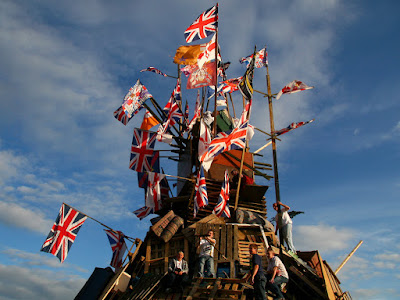
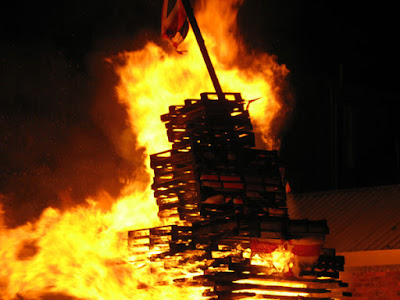
Driving home we see the results of a collection of wood that has been occurring the last few days in Derry, there is huge bonfires burning around the city, and on the side of the main road. The bonfires are lit as a form of protest, Aug 12 is against the catholic church and the Pope is burned in effigy, Aug 15 is against Britain, and the Queen is burned in effigy. It's interesting to see it, but also a little unnerving to see the huge crowds of people out protesting. After finally making it through the traffic of celebrators and lookey-loos, we head back to our B&B for a final night.
On a nice day with a few sprinkles, we would pack up and head across Northern Ireland to the capital of Belfast. Before driving into Belfast we would make a stop at Carrickfergus Castle.
Carrickfergus Castle was built in 1177, and after many years as a castle, a prison, a garrison, and even an air raid shelter during WW2, it is now a monument open to the public. The banqueting hall has been fully restored and there are many exhibits to show what life was like in medieval times. Throughout the castle mannequins have been setup representing the soldiers and royalty.
It starts raining a bit, so we head inside to check out the rooms representing life back in the day.
From the castle walls we look down onto Carrickfergus Harbour with Belfast in the background.
The town of Carrickfergus has some very interesting buildings, including this brick building, which is actually just a mural depicting a day in the medieval life, including throwing water from windows.
Belfast
Timing is everything as we leave, there is huge traffic lineups from people positioning their way along the shoreline to watch the tall ships. The Tall Ship festival has been occurring all weekend in Belfast, and this afternoon the ships are all leaving along the coast. Luckily for us, the traffic is all coming from Belfast, as we are going into Belfast. It wasn't even too hard to find parking.
First stop is the very useful TI which had an internet cafe, and they booked a room for us in Bangor what looks to be a nice seaside B&B. The streets are quite empty except for the lineups of people waiting for the big stores to open, on Sundays the shopping isn't allowed to start until 1:00 pm.
One of the most impressive buildings in Belfast is their City Hall. Plans for the Belfast City Hall began in 1888 when Belfast was awarded city status by Queen Victoria, During this period Belfast briefly overtook Dublin as the most populous city on the island of Ireland. The baroque style civic building covers one and a half acres at the centre of town, including its enclosed courtyard.
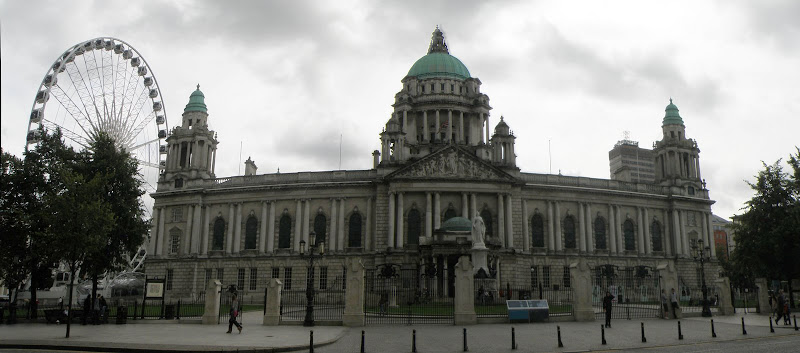
The Belfast Wheel is a 60 metre (200 ft) ferris wheel with 42 enclosed capsules, set on the grounds of Belfast City Hall. It opened in November 2007, and it's 15 minute ride gives amazing views over the city and harbour. It's nice that the capsules are air conditioned.
Tucked unceremoniously underneath the Belfast Wheel is the Titanic Memorial... "Erected to the imperishable memory of those gallant Belfastmen whose names are here inscribed and who lost their lives on the 15th April 1912, by the foundering of the Belfast-built R.M.S. Titanic, through collision with an iceberg, on her maiden voyage from Southampton to New York"
Throughout Belfast are many unique historical buildings, and modern structures.
From the Belfast wheel we walked down to the docks to see the Tall Ship Festival, then just as we walked into the festival area, they announced that it was over, "Thanks for coming".
At least we got to see some of the ships and a curious seal in the harbour.
Samson & Goliath are a pair of shipbuilding Cranes in Belfast harbour, they are both over 100 meters (300 feet) tall, prominent on the skyline, and have become landmarks of the city. Another landmark of the city is the Big Fish, a printed ceramic mosaic sculpture... don't ask, I don't know.
Since the Tall ship festival is closed, it's time to leave Belfast and head for our B&B.
Bangor
Bangor is a seaside resort town, once the key destination for pleasure seekers from Belfast during the Victorian era. When foreign holidays became more an more inexpensive, the resort aspect changed to a more residential town. Our B&B, the Cairn Bay Lodge is a seaside villa built in 1914.
We walked across our lawn to the beach for a shoreline stroll. As we trekked down the sand, one of the last tall ships sails by. It's really a magnificent and colourful area.
We went to great little local restaurant called the Jamaica Inn for dinner, then worked our way past the marina, and walked back through the small town to our B&B.
The sky goes blue as the sun goes down, and we head back into our seemingly magical entryway.
The owner of our B&B is a chef, and the breakfast in the morning is something special, I had local oak smoked salmon omelette, and Norine had a fruit medley with assorted breads.
Before leaving Bangor we went into town to check out their Town Hall castle. When Norine jumps out to take a picture, an older couple start telling her she should go inside and see the gardens. We tell them it is ok, we just want a picture, and the lady comes over to the car, and tells me "I am the mayoress, I'll open the security gate and you can park inside, the gardens are quite lovely."
When I come back the mayor and his wife are telling Norine about their trip to Vancouver, and we have a nice chat, he even takes our picture in front of the Town Hall. This imposing building built in 1852 is not so much a castle as an elegant 35 bedroom mansion in the Elizabethan-Jacobean revival style. The gardens have won many awards for their outstanding blooms. How many mayors do you know that would take time out of their day for a pair of tourists. I know one, in Bangor.
Strangford Lough
Rather than go back to Belfast and take the main highways back to Dublin, we decided to take the Ards Peninsula route around Strangford Lough. The island studded sea lough is the largest inlet in the British Isles. The first town on Strangford Lough is the historic town of Newtownards.
At the center of town is a 17th century octagonal Market Cross, and an even more impressive Town Hall that was built in 1770. While looking at a town map, an old guy comes up to help us incase we are lost, he tells us where all the major landmarks are, and then starts telling us about the statue in front of the town hall. It's a memorial to Lt Col Blair 'Paddy' Mayne, a native of Newtownards and one of the most decorated soldiers of the Second World War. The old guy and him must have been good friends. After checking out a couple cute little churches we moved on.
The town of Newtownards is overlooked by the 135-foot (41 m) high Scrabo Tower. The tower was erected in 1857 as a memorial to the 3rd Marquess of Londonderry, a General during the Napoleonic wars, in recognition of his kindness to the people during the great potato famine.
Heading down the lake we come to Mount Stewart, an 18th-century house and garden. It was the home of the Vane-Tempest-Stewart family, they are better known as the holders of the title Marquess of Londonderry, Lady Mairi born in 1921 still lives there. The tours of the house are at set times, and limited to small groups, we were in the first group, but had to wait 45 minutes.
While we are waiting for the tour, we wandered up to the scenic lake, there is lots of ducks, swans, and birds of a type we had never seen before. The ducks travel in large gangs/sords/flocks.
The lake has many picturesque areas including small bridges, piers and monuments, including a family burial ground and monument that is off limits to tourists.
We are finally taken on a tour through the house, it is still lived in, so is very representative of an actual mansion home from days gone by. Lady Mairi has kept the antiques and history of the house intact, and we get to see the many bedrooms, drawing room, children's room, and kitchens.
In the early 1920's Lady Edith redesigned the gardens in the most lavish way possible. In 1915 the gardens had just been plain lawns with large decorative pots. She added the Shamrock Garden, the Sunken Garden, increased the size of the lake, added a Spanish Garden with a small hut, the Italian Garden, the Dodo Terrace, the Fountain Pool and laid out walks in the rest of the estate. This dramatic change led to the gardens being proposed as a UNESCO World Heritage Site.
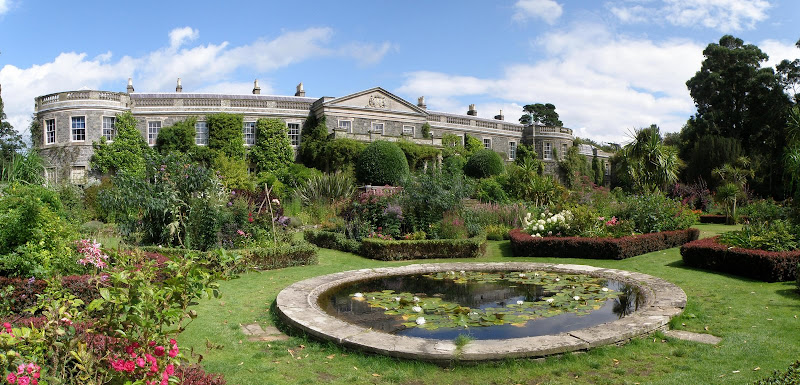
The gardens are truly great, and each garden is different. Throughout the Dodo terrace gardens is a menagerie of animals and mythic figures, they give the garden a really fun and light-hearted feel. After her husband died, Lady Edith gave the gardens to the National Trust in 1957.
Can you see the frog below the Ark?
As we leave Mount Stewart gardens and are heading towards the next small town, we pass the Kirkistown castle on the side of the road. It is an impressive three-storey tower house, built in 1622, it was occupied until 1731, when it was deserted. We can only take pictures from the road, or at least we can't find a road that takes us into the property, so it's a quick photo stop.
We drove down a windy road into Kearney, a tiny fishing village of white-washed houses,and National Trust seaside town. Although it's interesting to have seen it... yawn, time to go.
Throughout the area small tower forts are located in what I guess to be strategic locations.
As we are working our way towards the bottom of Strangford Lough we see a castle through the trees. It's Quintin castle a private residence, I snuck up the driveway, then ran away.
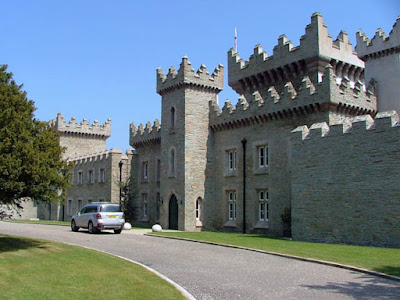
Unlike everywhere else we went, this area was full of cows instead of sheep.
Austin sent us on a detour down the wrong way to an area known as Portaferry, but not the town of Portaferry, causing us to miss the ferry in Portaferry. The ferry connects the bottom of the peninsula with the mainland, the crossing between Portaferry and Strangford takes 8 minutes. We are first in line as the ferry is pulling away, and now we have a 30 minute wait, oh well.
We used the time to book a room closer to Dublin at the nearby TI, since we were in Northern Ireland their computers didn't connect to the B&B network in Ireland, so the guy at the TI let us look through a Bed and Breakfast guide and use their phone to call B&B's until we found one.
Finally we are on the ferry, and then stopped for a very late lunch in Strangford before heading to the 820 acre estate of the 18th century Castle Ward. Between missing the ferry and having lunch, we arrive 30 minutes too late for a tour of the castle, but we can still wander the grounds.
The entrance side of the building is done in Classical style architecture, the opposite side is distinctly Gothic, the result of disputed tastes between Lord and Lady Bangor.
Temple Water is a man made lake at the center of the property. At one end of the lake is the 16th century Audley’s Castle ruins, and overlooking Temple Water is a majestic looking temple. From it's hilltop advantage, the temple has amazing views over the country-side to Strangford Lough.
The Ward family has lived on this estate since the 16th century. A short drive from the main castle is the Old Castle Ward, the original home and farmyard of the grounds, restored as an education center for kids and school groups to learn about history and farming.
If we had of arrived on time, we would have toured the rooms of the castle, instead we walked the trails circling Temple Water, and left. Time to follow St. Patrick's trail.
Just north-west of Downpatrick lies the ruins of Inch Abbey which was built before 800 AD, destroyed by vikings and later came back to life as a Cistercian monastery founded in 1180.
There is open access to the grounds, and we were alone as we wandered around the monastic ruins. It's not hard to imagine the structure with monks quarters, pews and stained glass.
From the grounds of Inch Abbey we look across a small lake at Downpatrick's Down Cathedral. Down Cathedral is part of the Church of Ireland. It was built in 1183 as a Benedictine Monastery. Saint Patrick was buried here in 461 AD on Cathedral Hill, within the grounds of Down Cathedral.
Our final stop in Northern Ireland is Killyleagh Castle, but it took us a while to find it, because there isn't any signs for it anywhere. It dominates the small village and is believed to be the oldest inhabited castle in the country, with parts dating back to 1180. For over 300 years this has been a private residence, signs ask us to respect their privacy, but a group of people are picnicking and playing on the grass lawn... it looks like the worlds oldest yard sale on the castle grounds.
Having completed our detour around Strangford Lough, it's time to head south and leave North Ireland. It's not very far to the border and the Bru na Bóinne area north of Dublin.


